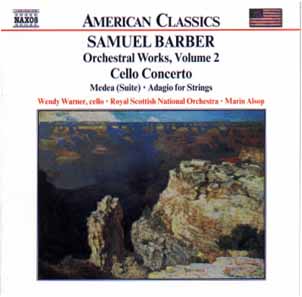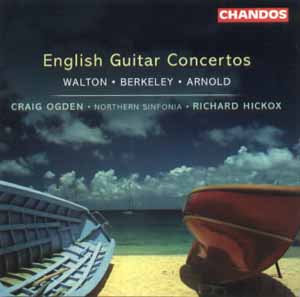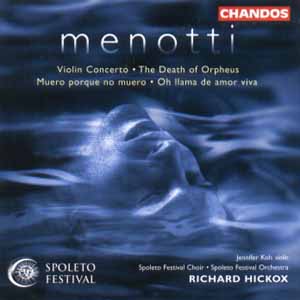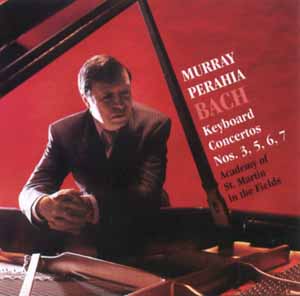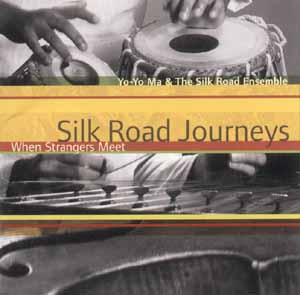Music Reviews
Classical Music - Part 34 - May, 2002
Jason Serinus
Ratings: Extraordinary Good Acceptable Mediocre Poor
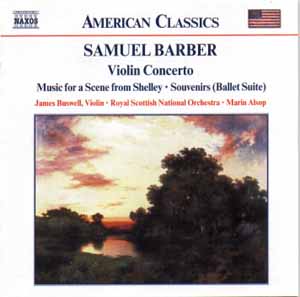
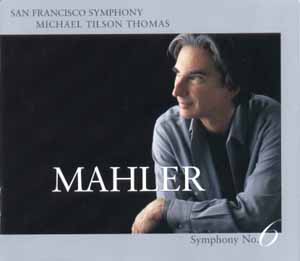
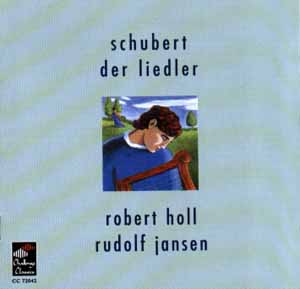
ENGLISH GUITAR CONCERTOS � CRAIG OGDEN, GUITAR/NORTHERN SINFONIA, RICHARD HICKOX COND. � CHANDOS 9963
Performance:
Sonics:
Looking for some lovely music that won�t leave you so deep in thought that you�ll be unable to communicate with the outside world for several days? Try these four delightful twentieth century English guitar concertos, all written for the great guitarist Julian Bream.
This 66-minute disc contains four captivating works by Sir Malcolm Arnold (b. 1921), Sir William Walton (1902-1983), and Sir Lennox Berkeley (1903-1989). Given the 2002 centenary of Walton�s birth, and next year�s Berkeley centenary, the timing is propitious.
Walton�s Five Bagatelles, written late in his life, are dedicated to his friend Malcolm Arnold. Originally commissioned and edited by Bream, they were subsequently orchestrated by Walton, Here they are heard in Patrick Russ� adaptation; appropriately retitled Five Bagatelles for Guitar and Chamber Orchestra, the arrangement is so faithful to Walton�s original that it was approved by the composer�s wife.
Another late work, Berkeley�s Guitar Concerto Op. 88, experiments with atonality while remaining seductively lyrical. Arnold�s Serenade for Guitar and Strings, Op. 50, written with Bream�s feedback, reflects the two men�s love of jazz. Finally, Arnold�s The Guitar Concerto, Op. 67 attempts a musical representation of elements of Bream�s character and personality.
Guitarist Craig Ogden, ably complemented by Richard Hickox and the Northern Sinfonia, plays with a beguiling ease and freedom. The sonics are warm and airy, ideal for the repertoire. While there�s a lot of up-tempo music to be heard here, the overall feeling is one of unforced lyricism. All in all, a perfect disc to hold one�s interest on a rainy afternoon.
MURRAY PERAHIA � BACH KEYBOARD CONCERTOS 3, 5, 6, 8 � ACADEMY OF ST. MARTIN IN THE FIELDS � SONY SK 89690
Performance:
Sonics:
Following up his magnificent recording of Bach�s Goldberg Variations, pianist Murray Perahia gifts us with his final installment of Bach�s tuneful Keyboard Concertos.
Conducting the Academy of St. Martin in the Fields from the keyboard, Perahia easily meets the composer's challenges. It is hard enough to play Bach�s many notes with ease; it takes a true artist to create a cogent musical line, artfully alter the dynamics and subtle nuances of repeated passages while maintaining classical poise, and make a modern piano sound almost as light and clear as the smaller instrument Bach employed.
Perahia does it all. His fingers virtually dance over the keys in the zippy allegros, seemingly recreating the joy and freshness that Bach experienced at the point of creation. When the music grows slower and more profound, however, he accesses a different level of spirituality, touching deeply with the writing�s lyrical beauty. Such are the distinctions of genius.
Bach sparkling keyboard concertos, the first of their genre, offered him new opportunities for artistic and virtuosic expression. Some are reworkings of violin concertos; Concerto No. 6 in F Major in particular, derived from the Brandenburg Concerto No. 4 in G Major, will delight as it sheds new light on Bach�s genius. The sonics are as winning as the performances.
MULTI-CHANNEL SACD
MAHLER: SYMPHONY NO. 6 IN A MINOR � SAN FRANCISCO SYMPHONY, MICHAEL TILSON THOMAS, COND. � SFS MEDIA 821936-0001-2Performance:
Sonics:
On May 27, 1906, after leading the dress rehearsal of his tragic Symphony No. 6, Gustav Mahler so feared the darkness he had unleashed with his music that he walked up and down the artists� room, sobbing, wringing his hands, unable to control himself. Over 95 years later, on September 11, 2001, the day before Michael Tilson Thomas and the San Francisco Symphony were set to perform and record Mahler�s Symphony No. 6, much of America was in a similar state, experiencing the hideous consequences of terrorism.
Rather than succumb to collective shock and scrap long-laid plans to perform and record the work, MTT and forces channeled all their anguish and heartbreak into the music. The result is perhaps the most stunning, carefully thought out, deeply moving performance of the symphony on record.
Tilson Thomas begins the work at a fast clip, indulging not a moment in sentiment. One is immediately struck by the meticulousness of the playing, every soloist evidencing subtle accents that reflect the conductor�s all-encompassing understanding of the work. Mahler�s vision is vast, and MTT is right there with him, moving from quasi-pastoral hillsides filled with the soft sounds of cowbells to moments of ecstasy and prolonged periods of despair with a conviction that makes sense of Mahler�s musical meanderings. When the military marches through whatever brief moments of peace and tranquility Mahler can find for himself, Tilson Thomas marches with him, voicing emotional swings so great that they require almost 90 minutes to express. The Andante is gorgeous, the 31-minute final movement so perfectly executed that its period of silence and stillness are as shattering as its many climaxes.
This is also unquestionably the best-sounding recording of the work. Available from www.sfsymphony.org or at major outlets, it is recorded in multi-channel SACD, a process that allows SACD players to reproduce sound virtually as good as that offered by analogue lp. Listeners with conventional two-channel CD playback will join this reviewer, enjoying fine sound from the same two-disc set.
Over the next few years, MTT and the SFS will release recordings of the remaining Mahler symphonies. Although it�s a shame that their recent mesmerizing performance of Mahler�s great Das Lied von der Erde was not similarly recorded, music lovers � hell, even rock lovers who want to be blown away � have much to look forward to.
BARBER: VIOLIN CONCERTO � NAXOS 8.559044
Performance:
Sonics:
BARBER: ORCHESTRAL WORKS VOL. 2 � NAXOS 8.559088
Performance:
Sonics:
Bargain label Naxos continues its Samuel Barber series with two new releases. The most outstanding of the two features violinist James Buswell with Marin Alsop conducting the Royal Scottish National Orchestra in a delicious pairing of the great Violin Concerto, Op. 14 with the student Serenade for Strings, Op. 1; early Music for a Scene from Shelley, Op. 7; and mature Souvenirs (Ballet Suite), Op. 28.
The main work of interest is the great Violin Concerto. Completed in 1940 when Barber was 30 years old, it was premiered the following year by the Philadelphia Orchestra conducted by Eugene Ormandy. This is an enticingly lyrical work, characterized by soaring melodies that go right to the heart. The sonics are not as full, rich and spacious as that on full-price performances by violinists Hilary Hahn and Gil Shaham; nor can Buswell, who plays quite well, equal either the speed of Hahn�s breathtaking finale or Shaham�s rich low tones, subtle shading, and myriad accents. Nonetheless, for those who have never heard this marvelous romantic masterpiece, initially considered unplayable by the industrialist who commissioned it, this low-price issue is a definite thumbs-up.
Another strong recommendation goes to the second volume of Barber�s orchestral works, featuring the same orchestra and conductor performing the lyrical Cello Concerto, Op. 22 played by Wendy Warner; the driving Medea Ballet suite, Op. 23 originally created for Martha Graham; and the beloved Adagio for Strings, Op. 11.
Barber may have won the Fifth Annual Award of the Music Critics Circle of New York for his engaging cello concerto, but it is far less known than the violin concerto � all the more reason to give it a hearing. Composed in 1945 for cellist Raya Garbousova, the work was premiered by her the following year with the Boston Symphony Orchestra conducted by Sergey Koussevitzky. The work is in some ways more daring than the Violin Concerto, less conventionally lyrical and frequently more piquant.
The familiar Adagio for Strings dates from 1936, when it formed the central movement of Barber�s String Quartet in B minor, Op. 11. Barber orchestrated the adagio the following year, in response to a request for an orchestral work from Arturo Toscanini. Frankly, the string quartet version is far more intense than the oft-heard orchestral rendition. But for those who consider this a mellow work, this performance will surely fit the bill.
Finally, for those who have had enough of Barber�s Adagio, Barber and Graham shakes us up with the Suite from Medea. Derived from Barber�s 1946 score for Graham�s ballet Medea, the seven-movement suite heard here was first performed the following year by the Philadelphia Orchestra conducted by Eugene Ormandy. This is driving, vehement, and oftentimes bitter music that climaxes with Medea�s slaying of her children. Great stuff.
MENOTTI: VIOLIN CONCERTO ETC. � SPOLETO FESTIVAL ORCHESTRA, RICHARD HICKOX, COND. � CHANDOS 9979
Performance:
Sonics:A mixed reception must be accorded this disc devoted to the music of Samuel Barber�s life-long companion and close friend, Gian Carlo Menotti.
Born in northern Italy in 1911, Menotti met Barber when they were both students at the Curtis Institute of Music in Philadelphia. The still-productive Menotti has achieved lasting recognition thanks to his one-act opera Amelia Goes to the Ball; post-WWII long Broadway runs of the operas The Medium and The Consul; and 1951 made-for-television opera, Amahl and the Night Visitors. He is also deeply respected for his 1958 co-founding of the Festival of Two Worlds at Spoleto and 1977 founding of its sister Spoleto Festival in Charleston, South Carolina. Nonetheless, even though he has now composed numerous concert works plus more than 20 operas for which he has written the librettos and sometimes directed the productions, his reputation has by and large been eclipsed by Barber�s.
This disc provides some justification for Menotti�s mixed reputation. The Concerto for Violin and Orchestra was composed in 1952 for violinist Efrem Zimbalist, and premiered the same year by Eugene Ormandy and the Philadelphia Orchestra. As sweetly played by Jennifer Koh, winner of the Tchaikovsky International Competition and Concert Artists Guild Competition, it emerges as quite lovely. Although I cannot make much sense of the concluding tarantella, its first two movements are captivating. This work is well worth hearing and owning.
The same cannot be said for its companions, three premiere recordings of Spanish- and English-language cantatas. Variously composed between 1982 and 1991 for soprano, baritone, and tenor supported by chorus and orchestra, the performances are handicapped by soloists affected with bleating sheep syndrome in their high range and music that ultimately seems banal.YO-YO MA AND THE SILK ROAD ENSEMBLE - SILK ROAD JOURNEYS: WHEN STRANGERS MEET - SONY SK 89782
Performance:
Sonics:World music? Crossover? Jettison the categories! This ear-opening recording, which originated with ethnomusicologists spending three years collecting material from composers and musicians in China and Central Asia, offers such an enlightening, ingratiating fusion of diverse influences that pigeonholers have no choice but to bow before its ceaselessly inspired delights.
Renowned cellist Yo-Yo Ma, whose collaborative creations with dancers and musicians from highly diverse backgrounds could teach UN peacemakers a thing or two, here presents us with the first disc from the Silk Road Ensemble. Its 12 tracks offer an international assemblage of 23 musicians performing traditional and modern works that reflect influences from Mongolia, China, Persia, Finland, Japan, Iran, Italy, and 21st century performance practice. We've got Asians playing western instruments, a Caucasian playing tabla, a Japanese composer setting five Finnish folk songs, and a unique setting of the Italian Renaissance street song, "Chi passa per'sta strada," played by an ensemble which includes Chinese lute (pipa), Indian drums (tabla), and Stradivarius cello. Some of the music is sweet, some quite intense, with some striking transitions of harmony and feeling.
Want to have your mind blown? Listen to Ganbaatar Khongorzul scale the sonic heights as she performs the short Mongolian Traditional long song that begins the disc. The woman's voice is a wonder. Not only can she cut through glass without leaving a single shard behind, but she's also capable of modulating volume and timbre with a mastery that will leave most singers envious.
Many of the compositions, especially the traditional tracks from Mongolia, China, and Persia, offer harmonies and scales frequently encountered by lovers of "world music." In addition, we have eight original works, some specially commissioned for the project, which occasionally push the expectation envelope. There is also a brief bonus excerpt from Tan Dun's beautiful score for the filmCrouching Tiger, Hidden Dragon.
The most adventurous work, inspired by the traditional music of Azerbaijan and the 20th century avant-garde compositions of American John Cage, is Franghiz Ali-Zadeh's "Habil-Sayagy (In Habil's Style)," named for contemporary kemancheh (spike fiddle) player, Habil Aliyev. The work features Yo-Yo Ma's cello evoking the sounds of the kemancheh, and Joel Fan's prepared piano evoking evokes traditional Azerbaijani and Middle Eastern instruments such as gosha nagara (kettle drums), tar (long-necked lute), qanun (plucked zither) and oud (short-necked lute). Ma is a wonder here, maintaining consistently beautiful tone even when sawing away with relentless ferocity. Equally amazing is Fan on piano. Thanks to mutes, mallets and a string of glass beads inserted between piano strings, Fan produces sounds so chameleon-like that, until scrutinizing the liner notes, I was certain a kettle drum had been added to the mix.
Don't turn your volume up too loud at the start of the disc. The recording has a huge dynamic range, most evident when three percussionists get going in Byambasuren Sharav's 11-minute "Legend of Herlen." Those with audiophile systems will discover that multi-miked instruments sometimes inhabit different acoustic spaces, each with their own resonance. Other than that drawback, this disc is a solid 10 from start to finish.
SCHUBERT DER LIEDLER - ROBERT HOLL, RUDOLF JANSEN - CHALLENGE CLASSICS CC 72042Performance:
Sonics:The great English accompanist Graham Johnson was once quoted as saying that of all the lieder singers now before the public, bass-baritone Robert Holl is the most spiritual of the lot. As the man responsible for the indispensable Hyperion Schubert and Schumann editions, as well as The Singer's Almanac series in Great Britain, Graham should certainly know what he's talking about.
I have waited many years until receiving a CD by Holl that would validate Johnson's belief. Finally, that disc has arrived.
Recorded in 1998, but first released in Europe in 2001 and in the U.S. in 2002, this recital features the Rotterdam-born Holl in partnership with the justifiably prized accompanist Rudolf Jansen. Together they offer 10 songs by Schubert, comprising a generous 74 minutes. While some of the songs, namely "Der Jungling und der Tod" and "An die Musik" are quite familiar, others, specifically the 17-minute "Der Liedler" and 14-plus minute "Viola," are seldom encountered.
Bass-baritone Holl came to public attention when he won first prize at the international singing contest in 's-Hertogenbosch in 1971. Studies with the great Hans Hotter and more prizes followed. The career has since taken Holl around the globe, featuring him in lieder, oratorio, and operatic roles ranging from Sarastro in The Magic Flute to Hans Sachs in a Bayreuth Die Meistersinger von N�rnberg.
How Holl sounded at the start of his career, or in 1990 when the Austrian government awarded him the honorary title of Wiener Kammers�nger, I do not know. But the voice as of 1998 was beautifully sonorous, with a resonance and depth that bring to mind the voice of his teacher, the great Hans Hotter. They also share a wobble in certain parts of the range that, while a minor distraction, is easily overlooked in Holl's case becaue of the beauty and depth of the voice.
Most important, there is the artistry. Holl displays a sensitivity, a sweetness, and a willingness to dive deeply into the Schubertian essence of a song that is rarely encountered, especially in a man. Nothing is rushed, self-conscious or forced; every nuance and ritard seems dictated by the musical essence of the lied at hand. In striking contrast to rising baritone Randall Scarlatta, whose recent Berkeley recital, accompanied by no less an artist than Richard Goode, suggested that this had yet to grasp the vastness of Schubert's vision, Holl sings as though these songs arise from the center of his being.
Even without translations, this disc takes one on a profound inward journey. Holl's singing is so deep that, in cases of mediocre poetry, ignorance adds to the bliss. Highly recommended.
- Jason Serinus -� Copyright 2002 Secrets of Home Theater & High Fidelity
Return to Table of Contents for this Issue.

